 By Gretchen Schuldt A man's brief interaction in a car with a woman at 3:30 a.m. did not justify the subsequent traffic stop that led to the discovery of an illegal gun in the man's car, the State Court of Appeals ruled this week. The decision reversed Milwaukee County Circuit Judge Dennis Cimpl's and vacated the felon-in-possession conviction of James Timothy Genous. Instead, the appeals panel said, the traffic stop was based on a "hunch" rather than reasonable suspicion. West Allis Police Officer Adam Stikl did not see a drug transaction before he stopped the vehicle driven by James Timothy Genous, the District I Court of Appeals panel said in an unsigned opinion. Stikl testified he stopped Genous after seeing a woman who matched the description of a known drug user come out of a house in the 1600 block of S. 65th St. – which officers testified was in a high drug trafficking area – get in Genous' legally parked black sedan for 15-20 seconds, then leave it to return to the house. Stickl said believed a drug deal had taken place based on his “training and experience,” according to the appeals panel, which included Appeals Judges William W. Brash III, Timothy G. Dugan, and M. Joseph Donald. Stikl stated that he had no information about a black sedan being used to transport drugs to that area, nor was Stikl aware of a black sedan belonging to a known drug dealer or drug user. "Stikl stated that he had no information about a black sedan being used to transport drugs to that area, nor was Stikl aware of a black sedan belonging to a known drug dealer or drug user," the panel wrote. Genous immediately pulled over when Stikl initiated the stop. Genous first said he was meeting his mistress, but that she failed to show. When Stikl said he had seen Genous with a woman, Genous acknowledged that a woman with the same first name as the suspected drug user had been in his car.
"He explained that the woman wanted money from him, but left when Genous did not give it to her," the panel said. Stickl testified at a suppression hearing that he saw "multiple cell phones, hand sanitizer, and cigar wrappers in the vehicle," the court wrote. Stickl said those things were commonly used by drug dealers. One of the officers who responded to the stop said Genous made "furtive gestures" wile in the car. "Stickl told Genous to sit on a curb and ordered Genous to remove his shoes and socks," the panel wrote. Another officer who had arrived at the scene looked in Genous' car and reported seeing a gun in plain sight. On appeal, the state argued that, given the totality of the circumstances, that the traffic stop was reasonable. "Genous argues that none of the facts relied upon by Stikl, either individually or cumulatively, were sufficient to constitute a reasonable suspicion that criminal activity was afoot. We agree," the panel said. "We are...unable to discern the required reasonable suspicion necessary to justify the investigative stop at issue," the panel said. "Stikl simply saw a woman enter Genous’s vehicle, remain in there for about fifteen to twenty seconds, exit the vehicle, and go back into her house...." the judges continued. "The fact that Genous’s encounter with (the woman) took place early in the morning in a known drug trafficking neighborhood does not give rise to reasonable suspicion. Stikl testified that drug transactions do not only occur at certain hours, and we have previously rejected the notion that drug transactions are more likely to occur in the middle of the night." Genous was represented on appeal by Assistant State Public Defender Leon W. Todd. (Full disclosure: Todd is a WJI Board member.)
0 Comments
WJI is taking a look at justice-related bills adopted in the 2019-2020 legislative session. 2019 Act 31 – Requires that a sentence for intoxicated use of a vehicle (OWI homicide) include a prison term of at least five years. The sentencing judge, however, may impose a lesser term if there is a compelling reason and the judge states the reason on the record. The law was introduced as AB 17; its companion Senate bill was SB 8. It was signed by Gov. Tony Evers on Nov. 20, 2019. Fiscal estimates Department of Corrections –$525,000 annually, including costs for treatment and contract jail beds. Courts – Fewer than 50 cases annually will be affected. Undetermined, minimal impact. District Attorneys – Unknown, minimal. Department of Justice – Unknown. Department of Transportation – None. State Public Defender – There may be a slight cost increase as extended threat of incarceration may cause an increase in the number of cases resolved by trial rather than plea. Testimony for Rep. Jim Ott – Assembly Bill 17 (SB 8) would impose a mandatory minimum of 5 years incarceration for committing homicide while driving drunk. While many judges sentence appropriately, there is no mandatory minimum. We sometimes hear of sentences of as little as a year or two being delivered, and at least one case of less than a year....The bill allows the judge to use discretion and sentence less than five years if the court finds that it is in best interest of the community, the public will not be harmed and the court puts its reasons in writing. Testimony against
None Mothers Against Drunk Driving and the Wisconsin Chiefs of Police Association Inc. registered in favor of the bill. The Association of State Prosecutors registered against the bill. The lead authors of AB 17 were Ott (R-Mequon) and Rep. Samantha Kerkman (R-Salem). The lead co-sponsors are Senators Alberta Darling (R-River Hills) and David Craig (R-Big Bend). 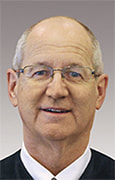 Griesbach Griesbach Two Milwaukee police detectives so badly violated the Miranda rights of a 16-year-old homicide suspect in 2008 that a federal judge last week granted a writ of habeas corpus and ordered that the man, now 28, be retried or released from prison within three months. By granting the writ requested by Ladarius Marshall, U.S. District Judge William C. Griesbach found that state court decisions in the case were “contrary to, or involved an unreasonable application of, clearly established Federal law." Marshall was convicted in 2010 for the slaying of Lavare Gould, who was shot and killed in the 2600 block of N. 37th St. on June 16, 2008. After his arrest, Marshall, who had cognitive deficiencies, repeatedly told Detectives Gust Petropoulos and Michael Braunreiter that he did not want to make a statement or talk to them, but the detectives persisted in their interrogation, Griesbach said in his ruling. Marshall was arrested in August 2008 at his grandmother's house after being implicated by a a co-defendant, Michael Winston. Marshall was taken to the Police Administration Building where he was put into a small, brick-walled interrogation room. He spent most of the day in that room and one like it, Griesbach said. And it was a long day. Marshall was put in the interrogation room at 7:36 a.m. He was finally taken to the Milwaukee County Children's Court Center about 10:30 p.m. First, Marshall sat alone in the interrogation room for more than three hours, Griesbach said. Then Petropoulos and Braunreiter read Marshall his Miranda rights. He declined to make a statement but agreed to answer questions. The teenager at first said he was at his grandmother's house at the time of the crime and had nothing to do with it. When the detectives said they had talked to the grandmother and knew that was not true, Marshall said, "Then I ain't talking no more...I ain't going to talk no more. I'm through talking. I don't want to talk no more." "Well, so you’re going to let other people talk for you?" asked Petropoulos. (In 2009, Petropoulos would win an award for a high 2008 homicide clearance rate, according to his Linked In page. "As a member of the Homicide Unit we achieved a 93% clearance in 2008," the page says.) "I’m through talking," Marshall said. "I ain’t going to talk no more." "Well, okay," Petropoulos said. "We’ll take a little break then...." The detectives left and returned more than two hours later. "Feel like talking?," Braunreiter said. "I got nothing to say," Marshall responded. Marshall was represented in his federal case by Shorewood attorney Matthew S. Pinix The detectives continued to talk to him and told him that some people were saying he was involved in the killing. Marshall said he was tired and ready to go to sleep, and Braunreiter said they should "get this done in a hurry then."
Marshall repeated that he was not involved and had nothing to say. About 4 p.m., he said it again: "I ain't got nothing else to say." "OK," Braunreiter said. "You want to take a little break?" "Yeah, that's what he said," Petropoulos said. The two detectives left. Marshall eventually asked to talk to Braunreiter alone. Story in a chart: State prison admissions tanked, releases held steady as virus emergencies declared4/23/2020 By Gretchen Schuldt Admissions into state prisons all but stopped after the Department of Corrections announced last month that it would not accept new inmates from counties, while the numbers of incarcerated released rose and fell, but did not show any dramatic swings, DOC figures show. The numbers also make clear that DOC has made little effort thus far to release additional inmates from prison during the coronavirus crisis, despite wide acknowledgement that jails and prison are breeding grounds for the virus and COVID-19, the potentially fatal disease it causes. Evers announced on March 22 that state prisons would not accept new inmates, shifting to counties the burden of holding those not suitable for release. He wasn't kidding. The number of inmates fell dramatically after the announcement, from 151 the week beginning March 15, to six the week beginning March 22. Releases, meanwhile, peaked the week of March 29, when 294 people walked out of prison. A week earlier, however, just 169 inmates were released, the lowest total in the weeks considered. Those incarcerated are frustrated with their conditions. The testimonials below have been edited for length, clarity and to protect the writers' identities. I know everyone in the community is dealing with this virus, and I don't feel like we are more important than any one of you by any means. But we are in the care of the system, we are at their mercy....I have no way of social distancing myself with 37 bunk beds crammed into one room 3 feet apart, with everyone sharing the same sinks, toilets, etc. If/when this virus reaches us, how will they take care of us? There are approx. 140 people between the 2 barracks here. We are sons, husbands, brothers, uncles, fathers (etc), and we MATTER! Please do what you can to bring our plight to someone who will do something about this situation BEFORE we become UNECCESSARY statistics! Take care of yourself and each other out there. *** We are on a lockdown from our day rooms, visiting, and the barber shop. Otherwise I'm not sure I'd say we are on a lockdown. The gym crowded, the library crowded, outside rec super crowded, and workers...packed close together serving our food – no masks for them. We are social distancing at the dinner tables; only two allowed at a table while eating. Two at a table outside. But big groups walking together. Only seen maintenance workers and a few others like laundry get masks. But there's others working, no masks being given to them for their safety. Governor Tony Evers ordered stay-home-safe bill with social distancing. This don't help an over-populated and over-crowded prison system. The coronavirus is here....Now the question is what will be done to stop the spreading of coronavirus? Do inmates and prison systems have to obey the Governor's stay-at-home-safe bill to stop spreading of coronavirus by social distancing? Why are some prison systems down playing the dangers of the coronavirus by letting inmates pack into a gym, library, in...with no masks serving food? Why is not everyone given cloth masks...to slow down spreading of coronavirus? Everyone in China is wearing some kinda mask on their face even if its cloth masks. What ever to stop this from spreading.
*** So, while most of the staff here are decent, caring people, and do have to contend with some less than pleasant situations from time to time, the info. presented to you on the (DOC) website is a tad misleading....There is no social distancing being practiced "during dining" here. We sit four to a table in a day room that doubles as a dining room with 90-100 guys all eating at the same time. Myself and some others try to keep a cushion of 6 feet while in the chow line and otherwise, but...fill in the blank. Furthermore, when you read that part about PPE's being made available to staff, you may get the impression that the staff are actually wearing these, but you'd be wrong. I have seen a couple of the teachers wearing masks, but that's it. The officers and other staff I see do not. I'm not sure what is promoting this "wait 'till it's here" mentality, but it just doesn't seem right. The ABC news this morning quoted someone @ (another prison) as saying they "don't know" how the three inmates who tested positive there became infected. You don't have to be a reporter to ascertain that it was most-likely transmitted by a staff member. By Gretchen Schuldt As the Department of Corrections continues to delay meaningful action to reduce prison populations in the state, incarcerated people are speaking out about conditions inside. The charts below show how little changed between the end of February, when the threat posed by the coronavirus became clear, and Friday, April 17. Below each chart is one or more testimonials from people living behind bars. The testimonials have been edited for length, clarity and to protect the writers' identities. There has been time to act. Gov. Tony Evers declared a public health emergency on March 12; he announced on March 22 that the State Department of Corrections would not accept inmate transfers from counties. Last week, the DOC announced it would distribute "four (4) disposable ear loop masks through canteen for all persons in our care in the near future." As far as what's being preached by the D.O.C. spokesperson Mr. (Kevin) Carr about what's being done in these places...to prevent the spreading of COVID 19, at best they are polished statements for the media. There isn't a day that goes by where guards aren't standing around in bunches as if there isn't a governor's mandate to practice social distancing. Showers are the equivalent of petri dishes because there are always more than 30 people, not counting the four to six guards that are in close proximity to one another. I personally feel like it's shower at your own risk. The so-called intense cleaning that is alleged to have taken place is non-existent. At best there were a few days of cursory wiping down the handrails on the stairs, and the handles of cell doors. Even that hasn't been done for at least a week. No real cleaning, especially the kind that should be required for this particular level of potential crisis, is taking place. Nor have we been given anything more than normal to sterilize these cells. The North cell hall is being used as a quarantine station because there are doors in that building rather than bars. However, there are many small holes in the door, and in the barrier next to the door....The entire building has to walk pass those cells to get to the showers rather than having everyone use the other side of the building to get there. The only building in this institution with truly solid doors is the segregation unit. It would make more sense to clear out one of the wings of that building for quarantine use. That way no one apart from staff would have contact with them.... Now we are being told that rather than continuing to have the medical staff bring medication and/or seeing guys on the unit that they live on, passes will be issued for them to go to that building, and risk coming into unnecessary contact with several people. This is a major concern for me because I have medication orally daily. I will not refuse my medication, but I will refuse to risk infection by going on an issued pass. Those are just a few of the many concerns I, and many others in this place have. SOMEONE NEEDS TO STEP UP AND LOOK INTO THIS INSTITUTION AND IT'S HEALTH CARE FOR US ASAP. There have been inmates in quarantine in HSU (health services unit) & also seg. w/no property they are not allow to use the phone or even send out their mail. So their family do not know what is going on here. Their rights are being violated. They are being punished for this COVID-19 they might not even have it. They should be allowed their property. I ask the Sgt why these inmates can't be on the north side of seg. so they can have their property. He told me he does not know. The people on the street have rights in their house to watch TV & have their property when they are quarantined, but we are in prison we are not allowed. If they quarantine me they will not be happy with me I will be complaining everyday if I'm in seg or HSU with out my property. I attempted to protect myself by wearing a mask provided by HSU staff. I was disrespected and aggressively confronted by (a sergeant) and staff ...requesting I throw away the mask or give it to him personally. I then asked him why I have to give up my (P.P.E) without reason and asked why when it's stated on news and recommendations from (Govt.) to wear these masks and practice preventive measures. I am aware that medical staff and guards here a primary source of transmission of (Covid-19) since they are in contact with the general public and have no physical proof or quarantined measures before entering the prison population daily . We have no way of effectively distancing ourselves from them or anyone else who may be harmful to our health and safety, and we need to know what's being done on this matter. I wish not to be penalized and punished for exercising my right to survive. I was told I could create panic, as if the...individuals who already have it from staff and the threats of further lockdown doesn't create enough panic. They had a big meeting with all the inmates with cpap (continuous positive airway pressure) machines. They gave us the option of giving up our cpap machines or be moved to the treatment center....They told us that we are considered "high risk" to contract the virus due to our cpap machines so if we wanted to keep our machines we would have to relocate to the treatment center. A lot of inmates gave up their machines to avoid being on the same unit as the coronavirus-quarantined inmates. What I don't understand is if we are "high risk" why would the administration put us on the same floor as the people with coronavirus? This policy just doesn't make any sense. We are being forced to either suffer sleep apnea and possibly die in our sleep just to avoid being near coronavirus-infected inmates or keep our machines and live within feet of infected inmates. What kind of a choice is that? I would think you would house the "high risk" inmates as far away from quarantined inmates as possible...Governor Evers really needs to act before it's too late....I chose to keep my cpap machine so I feel like I'm sitting on death row just waiting for this coronavirus to hit (here). Thank you for your time.
WJI is providing summaries of justice-related laws adopted in the 2019-20 legislative session.
2019 Act 8 – Delays closing of scandal-plagued juvenile prisons Lincoln Hills and Copper Lake from Jan. 1, 2021 to July 1, 2021. Also allows the Department of Correction to temporarily move juveniles out of Lincoln Hills to a qualifying juvenile detention facility prior to the opening of new state secure facilities; eliminates the requirement that, to qualify for funding, some secured residential care centers for children and youth (SRCCCYs) be only for females; allows counties with SRCCYs that serve out-of-county residents to qualify for youth aid bonuses; and generally requires approval of the local governing body before the state makes changes to a state secure facility. The law was introduced as AB 188; its companion Senate bill was SB 168. The bill passed the Senate, 33-0; the Assembly approved it without a roll call vote. It was signed by Gov. Tony Evers on June 28, 2019. The legislation was a trailer bill to 2017 Act 185. Fiscal estimates Department of Corrections –Previously estimated it would cost $1,186,000 in FY20 and $10,544,800 in FY21 to establish one secure juvenile facility and provide supporting staff by January 1, 2021. This bill will move the closure date of (Lincoln Hills) and (Copper Lake) into FY22. Prior to opening the new... (secure facilities), DOC will need budget and position authority to begin the process of hiring staff, developing institution policies and procedures, and developing programs. In accordance with DOC's staffing plan, budget and position authority will still be needed in FY20 and FY21 for a July 1, 2021 deadline....The impact of this bill will require DOC to simultaneously work to establish new Type 1 JCFs while continuing to provide services at its existing Type 1 JCFs. This bill does provide any additional budget or position authority increase. Department of Children and Families – Unknown. Department of Health Services –Unknown. Governor's budget provided $3,159,500 and 50.5 full-time equivalent positions in existing to open a 14-bed expansion using existing space at Mendota Juvenile Treatment Center. An additional $59 million budgeted for a 50-bed addition for both males and females. Legislation, however, did not include funding for staffing the expansions. Department of Public Instruction – Unknown. Department of Safety and Professional Services – None. Legislative Audit Bureau – Unknown. Testimony for Rep. Michael Schraa – I was in the room when Governor Walker agreed to extend the original timeline to accomplish this momentous task. Although he was committed to his ambitious timeline, he agreed to allow more time in deference to the needs of the counties. Several legislators have asked why we want to extend the timeline yet again. I absolutely do not support Governor Evers' proposal for an indefinite timeline. Troubled youth deserve a timely solution. Unfortunately, we lost a lot of momentum in the executive transition. The result of which is that the counties have not received the timely response from the Juvenile Corrections Grant Committee that we had envisioned. The counties have requested six more months, so it is in everyone's best interest to make it possible for them to participate. I cannot stress strongly enough that the state cannot accomplish this juvenile corrections reform without the full participation of the counties. Shannon Reed, DOC assistant deputy secretary – In our current system, local law enforcement officials, human services agencies, prosecutors, and judges have significant discretion and influence on whether and how youth land in secure facilities at the county level or at the state Department of Corrections. The decision to place youth in a secure setting rather than a less secure residential facility, or some other diversionary or community-based justice program, is decided at the local level. So, it is not enough to simply want there to be fewer children placed in secure settings, as many in this room have stated. It is a matter of all of us who have influence in this process to work together toward the trauma-informed programming, consistent staff training, community involvement, mental and physical health services, and other steps that research tells us increases the likelihood that youth will successfully re-integrate into their families and communities. Right now, there are 168 youth assigned to Lincoln Hills and Copper Lake Schools. This is a decrease of nearly 80% over the past 17 years. Today, 90% of our youth are identified as having one or more significantly adverse childhood experiences and almost half of the youth are enrolled in special education. More than 75% of the boys and 100% of the girls at Lincoln Hills and Copper Lake are receiving mental health services, in addition to the about 13% of boys who are currently placed at Mendota Juvenile Treatment Center for a serious mental health condition. As Governor Evers said yesterday, we want to close Lincoln Hills and Copper Lake but we also have to look at the entire youth justice system that considers the continuum of offenses and offenders and where they are mentally and educationally. We at DOC agree a comprehensive plan for juvenile justice in this state is the best path forward. We urge all those who care about the youth involved in the juvenile justice system to consider Act 185 and these technical fixes just the first step in reforming the way we help young people never return to a Department of Corrections facility. Youth justice should not be punitive. It should be a place where vulnerable children - no matter what bad decisions they have made - have the opportunity to overcome the trauma they have experienced in their young lives, receive the education and health treatment services they deserve, and learn the skills necessary to grow into citizens who will successfully contribute to their communities and to our state. The League of Women Voters of Wisconsin, Milwaukee County, and the National Association of Social Workers – Wisconsin Chapter and the Wisconsin Counties Association registered in favor of the bill. There were no registrations against the bill. The main authors of AB 188 were Schraa (R-Oshkosh) and State Rep. Evan Goyke (D-Milwaukee). Its two main co-sponsors were State Senators Van H. Wanggaard (R-Racine) and Lena Taylor (D-Milwaukee). By Margo Kirchner With courthouse closures and postponements of jury trials and other proceedings for weeks and months, at what point does justice delayed become justice denied? Legal experts brought together telephonically by the American Constitution Society recently discussed the issue in a briefing titled “Pandemic at the Courthouse.” The experts described effects of coronavirus social-distancing measures on the justice system to date, warned of dangers to constitutional rights, and noted a few bright spots that may lead to system improvement. The experts’ comments follow court orders around the country bumping jury trials for weeks or months; the U.S. Supreme Court’s postponement of April and May oral arguments; and the Ninth Circuit’s recent decision to suspend federal Speedy Trial Act requirements until April 2021. Elaine Poon, managing attorney of the Legal Aid Justice Center in Charlottesville, Virginia, noted that on the civil side, courts continue to work on several types of cases, especially cases brought by victims of domestic abuse. Nevertheless, Poon worries that with court slowdowns comes a decrease in protection of educational requirements for children with disabilities, fewer reviews of the status of children in foster care and conditions in immigration detention centers, and lack of attorney access to detainees. She is seeing juveniles in detention held in cells for too many hours each day due to social-distancing policies. And she worries about hearings being moved online when not everyone owns computers or phones. She noted, though, a “paradox” in that legal aid attorneys are in some cases celebrating court shutdowns. Many jurisdictions have stayed proceedings regarding eviction, debt collection, deportation, and termination of benefits activity. In her view, because of the lack of a right to counsel in most civil cases, for decades judges heard only one side of the issues in eviction and debt collection cases, and court decisions reflected that one-sidedness. With odds stacked against defendants in those cases, court shutdowns constitute a “ceasefire.” This ceasefire signals a silver lining of the current crisis, Poon said. The pandemic has caused judges and government officials to think about people’s health and wellbeing, which she considers a welcome change of perspective. Though she anticipates a flood of evictions and debt collection activity when COVID-19 restrictions are lifted, “we are seeing judges, we’re seeing lawmakers look at the law through the lens of public health and safety, and that’s an opportunity for us to continue to bend the system towards humanity,” she said. She cited as another positive the reconsideration of what constitutes an emergency. As an example, prior to COVID-19 restrictions evictions were considered emergencies for the landlords. The pandemic has changed that; evictions are now nonemergency matters that can be stayed for a tenant’s benefit. Jonathan Smith, attorney and executive director of the Washington Lawyers’ Committee for Civil Rights and Urban Affairs in Washington, D.C., and Shira Scheindlin, retired federal judge from the Southern District of New York, addressed the immediate and long-term effects of the pandemic on the criminal justice system. Scheindlin noted that although courthouses have been physically closed, state and federal courts in her home state have worked hard to remain open remotely. Jury trials, however, are on hold. According to Smith, as most courts are operating on a limited basis, many are restricting criminal work to felony arraignments and reviews of custody. Smith noted the work being done to reduce the flow of individuals into custody. The risk of COVID-19 spreading in jails and prisons is high; physical separation is impossible in such settings, and staff enter and exit the facility every day. And in the event of the spread of coronavirus in a prison, those infected may need to be transported to hospitals for treatment, he said. One method to reduce custody inflow that Smith is observing is police issuing summonses for future hearings rather than arresting individuals on the spot. For those arrested, Scheindlin opined that judges should be more willing to allow pretrial release if a case will be delayed. Nevertheless, Smith noted the troubling problem of unequal enforcement of stay-at-home orders in minority and low-income neighborhoods as opposed to white, privileged communities. He questioned whether enforcement strategies are being applied equally. According to Smith, a major focus of COVID-19 crisis advocacy has been reducing the numbers of those already in prisons and jails. Most success to date has occurred regarding jail populations. District of Columbia prisoners have been granted extraordinary good-time credits to achieve release, Smith said. The South Carolina Supreme Court permitted release of those in local jails unless release would create an unreasonable danger or extreme risk of flight, while the Massachusetts Supreme Court ruled that all pretrial detainees held on nonviolent offenses have a rebuttable presumption of release. The Kentucky Supreme Court told lower courts to review all cases in which the defendants may be susceptible to virus complications. The prison system has been more sluggish, said Smith. Petitions for release have been filed across the country, with little progress. The federal prison system notably has been slow to act; only a few individuals have been released to home confinement. In the face of the federal Bureau of Prisons’ lack of action, there is a groundswell of support for compassionate release of those over age 60 or with underlying medical conditions. Under the First Step Act, the BOP no longer controls compassionate release, said Smith. Instead, cases go back to sentencing judges, who are already recognizing the risk of COVID-19 as an extraordinary circumstance meriting release for those over 60 or vulnerable due to medical conditions. According to Smith, hundreds of attorneys are taking these cases to help secure release, though the BOP is opposing with alternate arguments: if COVID-19 is not present in a facility, the BOP argues lack of risk to the individuals in custody; if COVID-19 is present, the BOP argues that it is too dangerous to the community to order release. On a positive note, said Smith, these pandemic response efforts to reduce prison populations may be a test-run to show that de-carceration can work. Both Scheindlin and Smith noted complex issues regarding speedy trial rights. Though Scheindlin understands the inability to hold a trial with a panel of potential jurors, parties, and court staff in close proximity during a pandemic crisis, she worries that the pandemic will be used to erode protection of statutory and constitutional guarantees of a speedy trial. Disasters such as hurricanes or the 9-11 attacks previously closed courts for a short time ─ up to 30 days, for instance. Current court closures and pandemic response policies are lasting much longer, which raises concerns, said Scheindlin. She questioned in particular the lifting of Speedy Trial Act protections for a year. Pretrial detainees, in particular, she said are “presumed to be innocent and they could be stuck for a very long time incarcerated . . . unless we find a way to move the system along more quickly.” “We have to be careful and vigilant that [the pandemic] doesn’t become an excuse to take away our constitutional rights,” she said. Scheindlin also noted the need to safeguard the right to counsel in hearings held by telephone or video conference.
“It’s one thing to have a conference with your lawyer before the proceeding . . . but things happen during a proceeding where you need to consult with counsel,” she said. Though some technologies permit a virtual breakout room for attorney and client to confer, not all do. And valuable information is gathered by judge and parties being together in the same physical space, agreed Smith and Sheindlin. Said Smith: “It makes an enormous difference to have that physical presence” in a courtroom; remote proceedings can be artificial and uncomfortable for defendants. Scheindlin predicts a post-pandemic push to continue conducting many proceedings remotely. She sees dangers if that occurs. For instance, in criminal cases, judges in virtual hearings may rely heavily on documentation and possibly biased assessment tools rather than the judge’s personal assessment of the defendant in court. In addition, she said, remote proceedings will impact the public’s right to observe what is happening. “There’s nothing like the public being able to be there and participate in the system.” Smith and Scheindlin, like Poon, expressed concern over how courts will process the backlog of hearings and trials when they reopen. Scheindlin suggested that courts recruit a cadre of volunteer special masters to handle civil pretrial matters like discovery disputes. A recording of “Pandemic at the Courthouse Doors” is available as a podcast at https://www.acslaw.org/podcast/pandemic-at-the-courthouse-doors/.  Karofsky Karofsky State Supreme Court Justice-elect Jill Karofsky won in 17 of 19 Milwaukee County communities, losing to incumbent Dan Kelly in just Franklin and Hales Corners, both in the southern part of the county. Karofsky, a Dane County judge, did best in Shorewood, where she captured 86% of the vote, winning 5,105 to 826 with two write-ins. She captured 76% of the vote in Milwaukee, her second-highest share of the total. She won there, 68,230 to 21,524 for Kelly, with 155 write-in votes. Kelly's largest margin of victory was in Franklin, where he took 53% of the vote, beating Karofsky by 699 votes, 6,019 to 5,320 with six write-ins. He won 51% of the vote in Hales Corners, outpolling Karofsky by 48 votes, 1,231 to 1,183.
 Ross Ross By Shannon Ross I'll get right to the meat: Gov. Tony Evers and the Department of Corrections have far more than the two options they mentioned for releasing people. They mentioned in a statement only Certain Earned Release and Special Action Parole, but they can also employ Community Residential Confinement (DOC Administrative Code 327.04, which allows them to let parole-eligible people finish their time at home, on community custody), Emergency removal (325.01), which allows release during an emergency, and leave (326) (which allows them to grant furloughs to "nonviolent" individuals for extended periods to facilitate family reintegration and stability). They can talk to judges around the state about granting more sentence adjustments (two guys here with nonviolent crimes and histories were just denied, but get released within four months anyways). They can parole more people – many have somewhere to go and are set for release in the next year or two anyways, so what will it matter if they go home now after having served 20-30 years in prison? Most of all, Evers can commute the sentences of everyone with less than a year left to serve on their sentences (or less than six months or four months or whatever he wants). One of my cellmates is doing 5 months on misdemeanors right now. Does it make ANY DAMN SENSE to not commute his sentence amid this pandemic? The Certain Earned Release option he mentioned only applies to a smidgen of a crumb of a percentage of incarcerated people (I'd be shocked if it was more than .01%). Everyone else they mentioned releasing in press releases the last two weeks was from jails and Milwaukee Secure Detention Facility. They have effectively done nothing to address the potential danger in prisons. Before I address Evers' and the DOC's repeated puffery about what they are doing to keep us "persons in their care" safe, let me applaud them on the one thing they have done right: the FAQ and the transparent, up-to-date COVID status pages on the DOC website. The public and our loved ones are able to see in real time (supposedly) how many staff and incarcerated people have been tested, how many tested positive and at what facilities, and how many are awaiting results. DOC and Evers could have done their typical suppression of info under the comically North Korea-esque guise of security reasons, but they have endeavored for sunshine instead. Thank you. But it pretty much ends there.
They keep saying they have a plan, but judging from my experience and the hundreds of emails from incarcerated people statewide that I get in my role as manager of the most-widely read anti-mass incarceration publication in the state (thecommunitywis.wixsite.com/home), they seem like an infant learning to walk. Yes, they are providing two free phone calls a week (which, by the way, with the usurious phone rates they charge, is like stealing someone's car then claiming to be a good guy because you let them use it for free two times a week). But phone access has been curtailed at several facilities, especially where I am, and the calls commonly disconnect midway through (so much for a free 15-minute call when it hangs up on you within five minutes) and hardly anyone who was getting visits had problems with calling their loved ones in the first place (if you'll pony up $20-$50 for gas and snacks to visit someone in prison, you'll provide money so they can call you). The official line v. a description of life inside a Wisconsin prison: Same issue, different worlds4/10/2020
|
Donate
Help WJI advocate for justice in Wisconsin
|
Copyright © 2024 Wisconsin Justice Initiative Inc.
The Wisconsin Justice Initiative Inc. does not endorse candidates for political office. The Wisconsin Justice Initiative Inc. is a 501(c)3 organization.
The Wisconsin Justice Initiative Inc. does not endorse candidates for political office. The Wisconsin Justice Initiative Inc. is a 501(c)3 organization.



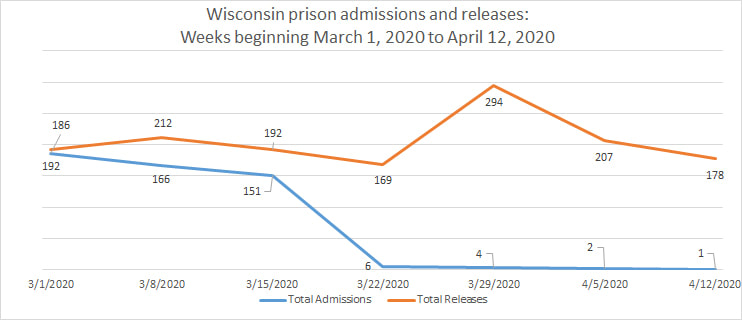

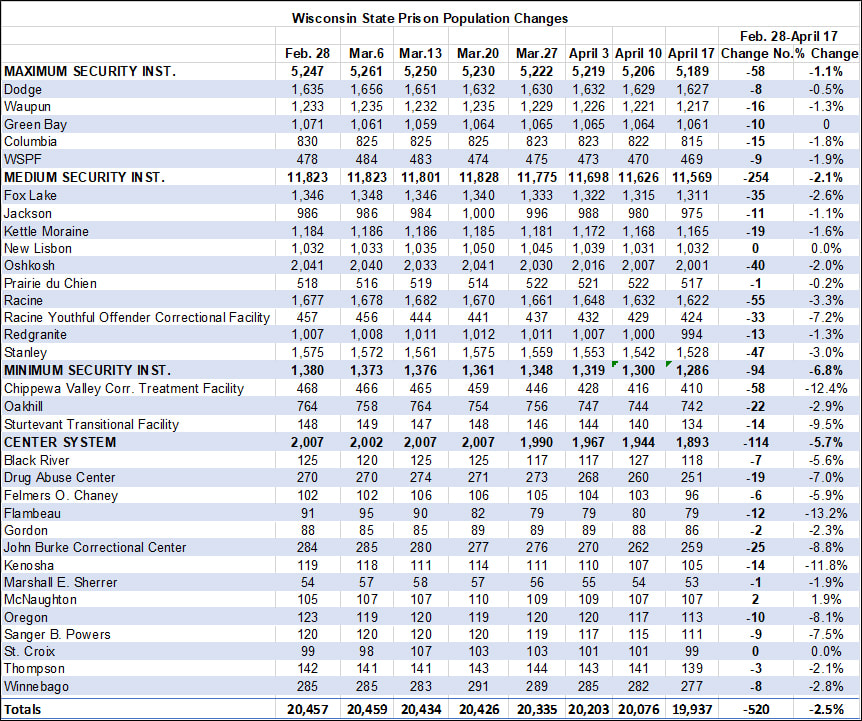
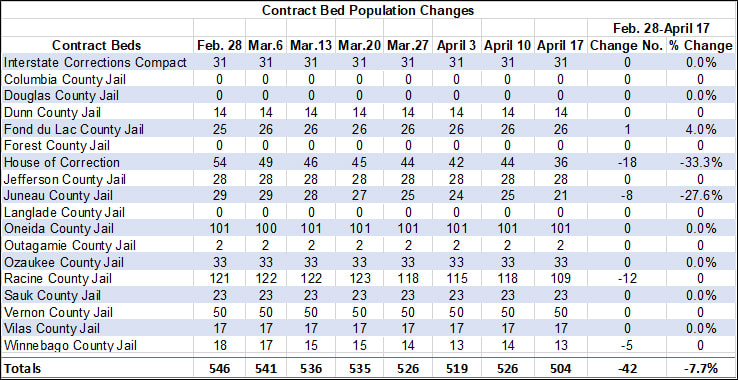
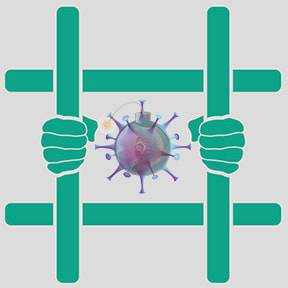
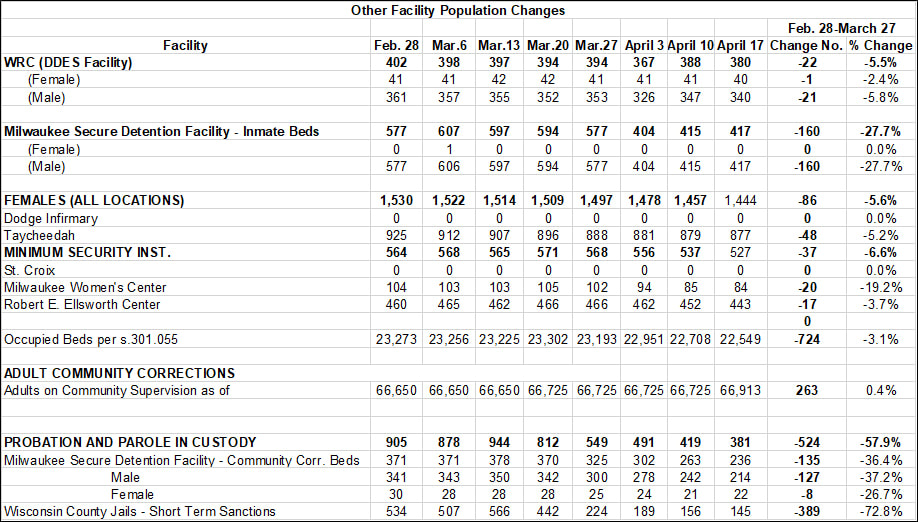



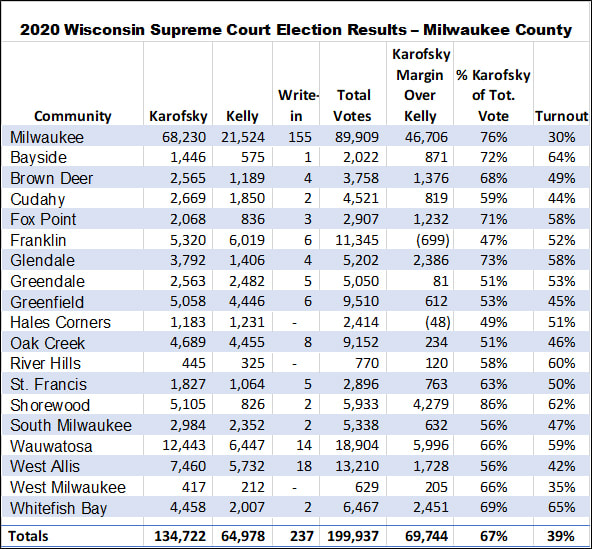

 RSS Feed
RSS Feed